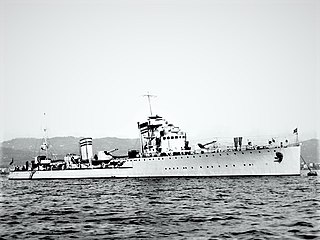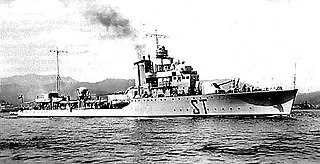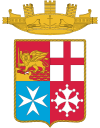Design and description
The Navigatori-class destroyers were designed to counter the large French destroyers of the Jaguar and Guépardclasses. [2] They had an overall length of 107.3 meters (352 ft), a beam of 10.2 meters (33 ft 6 in) and a mean draft of 3.5 meters (11 ft 6 in). [3] They displaced 1,900 metric tons (1,900 long tons ) at standard load, and 2,580 metric tons (2,540 long tons) at deep load. Their complement during wartime was 222–225 officers and enlisted men. [4]
Nicoloso da Recco was powered by two Tosi geared steam turbines, each driving one propeller shaft using steam supplied by four Odero water-tube boilers. The turbines were designed to produce 55,000 shaft horsepower (41,000 kW ) [4] and a speed of 32 knots (59 km/h; 37 mph) in service, although the Navigatoris reached speeds of 38–41 knots (70–76 km/h; 44–47 mph) during their sea trials while lightly loaded. [5] They carried enough fuel oil to give them a range of 3,800 nautical miles (7,000 km; 4,400 mi) at a speed of 18 knots (33 km/h; 21 mph). [4]
Their main battery consisted of six 120-millimeter (4.7 in) guns in three twin-gun turrets, one each fore and aft of the superstructure and the third amidships. [6] Anti-aircraft (AA) defense for the Navigatori-class ships was provided by a pair of 40-millimeter (1.6 in) AA guns in single mounts abreast the forward funnel and a pair of twin-gun mounts for 13.2-millimeter (0.52 in) machine guns. They were equipped with six 533-millimeter (21 in) torpedo tubes in two triple mounts amidships. Unlike her sister ships, Nicoloso da Recco was unable to carry any mines because her aft superstructure had been enlarged to accommodate an admiral and his staff. [5]

The Turbine-class destroyer was a group of eight destroyers built for the Regia Marina in the 1920s. The ships played a minor role in the Spanish Civil War of 1936–1937, supporting the Nationalists. All the ships of the class were lost during World War II.

The Navigatori class were a group of Italian destroyers built in 1928–1929 for the Regia Marina, named after Italian explorers. They fought in World War II. Just one vessel, Nicoloso Da Recco, survived the conflict.

The Maestrale class were a group of destroyers built for the Regia Marina and served in World War II. They formed the basis for subsequent Italian destroyer designs; the Oriani and Soldati classes.

Strale was one of four Freccia-class destroyers built for the Regia Marina in the early 1930s. Completed in 1932, she played a minor role in the Spanish Civil War of 1936–1939 supporting the Spanish Nationalists and served in World War II.

Leone Pancaldo was one of twelve Navigatori-class destroyers built for the Regia Marina between the late 1920s. Shortly after Italy's entry into World War II in June 1940, she was sunk by British torpedo bombers in Augusta, Sicily, but was later refloated and repaired. She was briefly used in fast troop transport missions to Tunisia until her second and final sinking by Allied aircraft in April 1943.

Alvise Da Mosto was one of twelve Navigatori-class destroyers, built for the Regia Marina between the late 1920s and the early 1930s. During World War II, she participated in several minelaying missions in the Sicilian Channel and escorted convoys between Italy and Libya until her sinking by the British Force K.
Ugolino Vivaldi was one of twelve Navigatori-class destroyers built for the Regia Marina between the late 1920s and the early 1930s.

Carabiniere was one of nineteen Soldati-class destroyers built for the Regia Marina in the late 1930s and early 1940s. Completed in 1938, she survived World War II to be scrapped in 1978.

Grantiere was one of nineteen Soldati-class destroyers built for the Regia Marina in the late 1930s and early 1940s. Completed in early 1939, she was one of the last of the first batch of a dozen ships to enter service.

Corsaro was one of nineteen Soldati-class destroyers built for the Regia Marina in the late 1930s and early 1940s. Completed in mid-1942, she was one of the second batch of seven ships.

Lampo was one of four Folgore-class destroyers built for the Regia Marina in the early 1930s. Completed in 1932, she served in World War II.
Nicolò Zeno was one of a dozen Navigatori-class destroyers built for the Regia Marina in the late 1920s. Completed in 1930, she served in World War II.
Antoniotto Usodimare was one of a dozen Navigatori-class destroyers built for the Regia Marina in the late 1920s. Completed in 1929, she served in World War II.
Luca Tarigo was one of a dozen Navigatori-class destroyers built for the Regia Marina in the late 1920s. Completed in 1929, she served in World War II.

Antonio Pigafetta was one of a dozen Navigatori-class destroyers built for the Regia Marina in the late 1920s. Completed in 1931, she served in World War II.
Emanuele Pessagno was one of a dozen Navigatori-class destroyers built for the Regia Marina in the late 1920s. Completed in 1930, she served in World War II.
Lanzerotto Malocello was one of a dozen Navigatori-class destroyers built for the Regia Marina in the late 1920s. Completed in 1930, she served in World War II.
Giovanni da Verazzano was one of a dozen Navigatori-class destroyers built for the Regia Marina in the late 1920s. Completed in 1930, she served in World War II.
Antonio da Noli was one of a dozen Navigatori-class destroyers built for the Regia Marina in the late 1920s. Completed in 1931, she served in World War II.
Quintino Sella was the lead ship of her class of four destroyers built for the Regia Marina in the 1920s. Completed in 1926, she served in World War II.
This page is based on this
Wikipedia article Text is available under the
CC BY-SA 4.0 license; additional terms may apply.
Images, videos and audio are available under their respective licenses.












